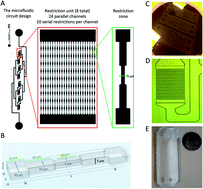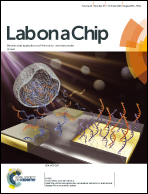A microfluidic approach to study the effect of mechanical stress on erythrocytes in sickle cell disease†
Abstract
The human red blood cell is a biconcave disc of 6–8 × 2 μm that is highly elastic. This capacity to deform enables it to stretch while circulating through narrow capillaries to ensure its main function of gas exchange. Red cell shape and deformability are altered in membrane disorders because of defects in skeletal or membrane proteins affecting protein–protein interactions. Red cell properties are also altered in other pathologies such as sickle cell disease. Sickle cell disease is a genetic hereditary disorder caused by a single point mutation in the β-globin gene generating sickle haemoglobin (HbS). Hypoxia drives HbS polymerisation that is responsible for red cell sickling and reduced deformability. The main clinical features of sickle cell disease are vaso-occlusive crises and haemolytic anaemia. Foetal haemoglobin (HbF) inhibits HbS polymerisation and positively impacts red cell survival in the circulation but the mechanism through which it exerts this action is not fully characterized. In this study, we designed a microfluidic biochip mimicking the dimensions of human capillaries to measure the impact of repeated mechanical stress on the survival of red cells at the single cell scale under controlled pressure. We show that mechanical stress is a critical parameter underlying intravascular haemolysis in sickle cell disease and that high intracellular levels of HbF protect against lysis. The biochip is a promising tool to address red cell deformability in pathological situations and to screen for molecules positively impacting this parameter in order to improve red cell survival in the circulation.

- This article is part of the themed collection: Lab on a Chip Recent HOT Articles


 Please wait while we load your content...
Please wait while we load your content...